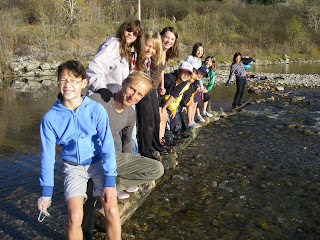When I was a kid, I loved sword fighting. Pretending I was a powerful warrior that could slay the enemies with one swift swipe of my weapon provided endless fun and was sometimes even useful work. At my uncle’s farm just north of Calgary, the enemy was Bull Thistle, a formidable foe with huge spikes and a menacing stature that was displacing edible pasture grass. Destroying the weed was satisfying, good exercise, which set me up to see a major paradigm in the natural world: the invasion of our ecosystem by non-native invasive plants.
The story of invasions by foreign plants and animals is a massive topic, equal in significance to climate change or urban sprawl and so widespread that scarcely any ecosystem adjacent to the settled parts of Canada has gone unaffected. To the south, Americans are battling not just weeds but invasive snakes, feral pigs, all sorts of Asian insects and fish, and English birds, including starlings, House sparrows, pigeons, initially brought over to keep immigrants from feeling homesick.
How can we as educators break this story down into interesting lessons that will create engaged citizens with a passion for preserving what beautiful biodiversity we still have left? Let me share a few ideas that have been a hit with the young students I have taken on classes in the woods.
At first glance, one is struck by how beautiful weeds can be. Ox-eye Daisy, Purple Loosestrife, Blueweed and the like have all found refuge in local flower gardens because of their prolific blossoms and bright display. But it’s not a beauty contest. It’s a matter of neighborliness. Every plant has co-evolved with a community of insects that have figured out over a long period of time how to make a meal out of leaves. Look at a native plant and you will find evidence of some species munching on it. Not so with the foreigners. In fact, one of the reasons the non-natives are doing so well is that they don’t have to deal with insects anymore, having left their pests back in their home country. Scientists who want to control these plants naturally, often go abroad and get these bugs, and after thorough testing to make sure their appetite is not going to switch to something native, will introduce these into the wilderness here.
Making a leaf collection is a great way for students to see connections in the ecosystem, noting all the different bugs that depend on the energy and specific chemicals produced by plants. Such as Monarchs munching on the otherwise unpalatable Milkweed. Meanwhile, a sampling of non-native leaves will reveal that they remain perfectly un-touched. The domino effect of losing native plants, then bugs, then birds alludes to a new Silent Spring. We have noticed that once common birds in Calgary like Kingbirds, Orioles, Canada Jays, Vireos, and many others have become scarce. Making these connections with a food web diagram and real leaves, is one place to start.
The other collection to be made is flower bouquets from all of the colorful weeds. Take a field trip in the latter half of Spring and bring back a collection of Goatsbeard, Knapweed, Star-thistle, or whatever is growing on your grounds. Use them to decorate the classroom without any guilt. Useful in our region, the book Wayside Wildflowers of the Pacific Northwest by Dr. Dee Strickler, has a rating system of what should be picked. In general, you can pick generous amounts of all weeds. But with common native plants like Yarrow or Vetch, you should pick just one or two. For rarer natives like orchids, take only pictures.
Have a contest in flower arranging or how big of vase can be filled. If you have a large area with untouched dandelions or chamomile, you can make edible salads or teas and eat your way through a weed lesson. You’d be surprised how many dandelion leaves can be consumed by students when diluted in a fruit juice smoothie, and just how delicious they taste.
A personal favorite way to get youth interacting with weeds is to launch a war. You will need just the right area with a lot of plants to work with, preferably a weedy forgotten corner of disturbed land somewhere. Dispense the armor, gloves for a simple pulling operation or some loppers for removal of bushes. We do this in late June (when academic absorption capacity is maxed out) in a small natural area near the school, chopping out the Cotoneasters and making a massive pile of their branches. Pulling down the vine of a giant Yellow Clematis, gives a sense of power. Kids love a challenge that requires some dirtiness and collaboration, and are often more capable than we imagine.
Ever heard of Burdock? The sticky plant that inspired Velcro, appeals to primary grade students as a cool hitch-hiker seed (Hound’s Tongue works well too). I once gave a mock flogging to a junior high student with a dried-up burdock, covering him in burrs. The student wore disposable clothes, but one can imagine what a pain it would be to have this plant all over you if you were a wild animal with no groomer. Small birds find their seeds a death trap. Removing it from the field makes a big difference. You can see the results right away.
Regardless of how it is done, choreographing some kind of destruction is always a hit with teenagers. It may only make a dent but it helps create a mentality of being a defender for our environment. Start with assessing what weed populations are around your school grounds and then choose your preferred method of interaction like a scavenger hunt, spreading vector map, or food web guide.
Often the best place to start is by asking the people who know the most about native plants, your local naturalist club or parks department for example. I was fortunate to find master plant identifier Gus Yaki of Nature Calgary, who taught me everything I know.
Incorporate at least one field trip to a natural area and introduce your students to their fellow citizens of the photosynthesizing kind. Think ahead and arm them with walking sticks. You never know if they will become swords for the next generation of weed warriors.









